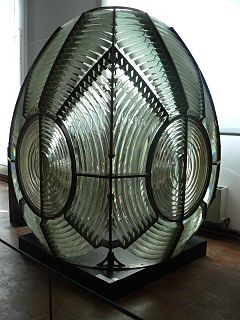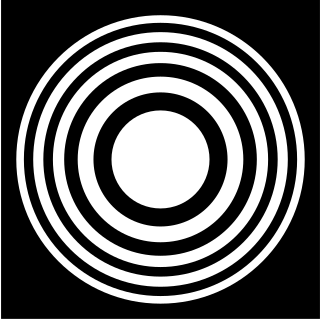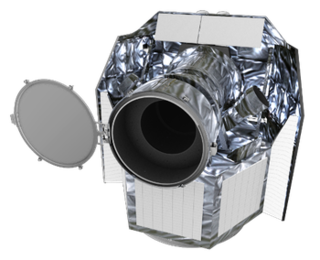Related Research Articles
A lens is a transmissive optical device that focuses or disperses a light beam by means of refraction. A simple lens consists of a single piece of transparent material, while a compound lens consists of several simple lenses (elements), usually arranged along a common axis. Lenses are made from materials such as glass or plastic, and are ground and polished or molded to a desired shape. A lens can focus light to form an image, unlike a prism, which refracts light without focusing. Devices that similarly focus or disperse waves and radiation other than visible light are also called lenses, such as microwave lenses, electron lenses, acoustic lenses, or explosive lenses.

Optics is the branch of physics that studies the behaviour and properties of light, including its interactions with matter and the construction of instruments that use or detect it. Optics usually describes the behaviour of visible, ultraviolet, and infrared light. Because light is an electromagnetic wave, other forms of electromagnetic radiation such as X-rays, microwaves, and radio waves exhibit similar properties.

A gravitational lens is a distribution of matter between a distant light source and an observer, that is capable of bending the light from the source as the light travels towards the observer. This effect is known as gravitational lensing, and the amount of bending is one of the predictions of Albert Einstein's general theory of relativity.

In optics, chromatic aberration (CA), also called chromatic distortion and spherochromatism, is a failure of a lens to focus all colors to the same point. It is caused by dispersion: the refractive index of the lens elements varies with the wavelength of light. The refractive index of most transparent materials decreases with increasing wavelength. Since the focal length of a lens depends on the refractive index, this variation in refractive index affects focusing. Chromatic aberration manifests itself as "fringes" of color along boundaries that separate dark and bright parts of the image.

A Fresnel lens is a type of composite compact lens developed by the French physicist Augustin-Jean Fresnel (1788–1827) for use in lighthouses. It has been called "the invention that saved a million ships."

The Very Large Telescope (VLT) is a telescope facility operated by the European Southern Observatory on Cerro Paranal in the Atacama Desert of northern Chile. The VLT consists of four individual telescopes, each with a primary mirror 8.2 m across, which are generally used separately but can be used together to achieve very high angular resolution. The four separate optical telescopes are known as Antu, Kueyen, Melipal, and Yepun, which are all words for astronomical objects in the Mapuche language. The telescopes form an array which is complemented by four movable Auxiliary Telescopes (ATs) of 1.8 m aperture.
Angular resolution describes the ability of any image-forming device such as an optical or radio telescope, a microscope, a camera, or an eye, to distinguish small details of an object, thereby making it a major determinant of image resolution. It is used in optics applied to light waves, in antenna theory applied to radio waves, and in acoustics applied to sound waves. The closely related term spatial resolution refers to the precision of a measurement with respect to space, which is directly connected to angular resolution in imaging instruments. The Rayleigh criterion shows that the minimum angular spread that can be resolved by an image forming system is limited by diffraction to the ratio of the wavelength of the waves to the aperture width. For this reason, high resolution imaging systems such as astronomical telescopes, long distance telephoto camera lenses and radio telescopes have large apertures.

An optical telescope is a telescope that gathers and focuses light, mainly from the visible part of the electromagnetic spectrum, to create a magnified image for direct view, or to make a photograph, or to collect data through electronic image sensors.
Optics is the branch of physics which involves the behavior and properties of light, including its interactions with matter and the construction of instruments that use or detect it. Optics usually describes the behavior of visible, ultraviolet, and infrared light. Because light is an electromagnetic wave, other forms of electromagnetic radiation such as X-rays, microwaves, and radio waves exhibit similar properties.

A coronagraph is a telescopic attachment designed to block out the direct light from a star so that nearby objects – which otherwise would be hidden in the star's bright glare – can be resolved. Most coronagraphs are intended to view the corona of the Sun, but a new class of conceptually similar instruments are being used to find extrasolar planets and circumstellar disks around nearby stars as well as host galaxies in quasars and other similar objects with active galactic nuclei (AGN).

A zone plate is a device used to focus light or other things exhibiting wave character. Unlike lenses or curved mirrors, zone plates use diffraction instead of refraction or reflection. Based on analysis by French physicist Augustin-Jean Fresnel, they are sometimes called Fresnel zone plates in his honor. The zone plate's focusing ability is an extension of the Arago spot phenomenon caused by diffraction from an opaque disc.
Antoine Émile Henry Labeyrie is a French astronomer, who held the Observational astrophysics chair at the Collège de France between 1991 and 2014, where he is currently professor emeritus. He is working with the Hypertelescope Lise association, which aims to develop an extremely large astronomical interferometer with spherical geometry that might theoretically show features on Earth-like worlds around other suns, as its president. He is a member of the French Academy of Sciences in the Sciences of the Universe section. Between 1995 and 1999 he was director of the Haute-Provence Observatory.

Apodization is an optical filtering technique. Its literal translation from Greek is "removing the foot". It is the technical term for changing the shape of a mathematical function, an electrical signal, an optical transmission or a mechanical structure. In optics, it is primarily used to remove Airy disks caused by diffraction around an intensity peak, improving the focus.

A telescope is an optical instrument using lenses, curved mirrors, or a combination of both to observe distant objects, or various devices used to observe distant objects by their emission, absorption, or reflection of electromagnetic radiation. The first known practical telescopes were refracting telescopes invented in the Netherlands at the beginning of the 17th century, by using glass lenses. They were used for both terrestrial applications and astronomy.

PLAnetary Transits and Oscillations of stars (PLATO) is a space telescope under development by the European Space Agency for launch in 2026. The mission goals are to search for planetary transits across up to one million stars, and to discover and characterize rocky extrasolar planets around yellow dwarf stars, subgiant stars, and red dwarf stars. The emphasis of the mission is on earth-like planets in the habitable zone around sun-like stars where water can exist in liquid state. It is the third medium-class mission in ESA's Cosmic Vision programme and named after the influential Greek philosopher Plato, the founding figure of Western philosophy, science and mathematics. A secondary objective of the mission is to study stellar oscillations or seismic activity in stars to measure stellar masses and evolution and enabling the precise characterization of the planet host star, including its age.

The International X-ray Observatory (IXO) is a cancelled X-ray telescope that was to be launched in 2021 as a joint effort by NASA, the European Space Agency (ESA), and the Japan Aerospace Exploration Agency (JAXA). In May 2008, ESA and NASA established a coordination group involving all three agencies, with the intent of exploring a joint mission merging the ongoing XEUS and Constellation-X Observatory (Con-X) projects. This proposed the start of a joint study for IXO. NASA was forced to cancel the observatory due to budget constrains in fiscal year 2012. ESA however decided to reboot the mission on its own developing Advanced Telescope for High Energy Astrophysics as a part of Cosmic Vision program.

CHEOPS is a European space telescope to determine the size of known extrasolar planets, which will allow the estimation of their mass, density, composition and their formation. Launched on 18 December 2019, it is the first Small-class mission in ESA's Cosmic Vision science programme.

The Atmospheric Remote-sensing Infrared Exoplanet Large-survey (ARIEL), is a space telescope planned for launch in 2029 as the fourth medium-class mission of the European Space Agency's Cosmic Vision programme. The mission is aimed at observing at least 1,000 known exoplanets using the transit method, studying and characterising the planets' chemical composition and thermal structures. Compared to the James Webb Space Telescope, ARIEL will have more observing time available for planet characterisation but a much smaller telescope.
Nautilus Deep Space Observatory (NDSO) is a proposed deep space fleet of space telescopes designed to search for biosignatures of life in the atmospheres of exoplanets.
References
- 1 2 L. Koechlin; D. Serre; P. Duchon (2005). "High resolution imaging with Fresnel interferometric arrays:suitability for exoplanet detection" (PDF). Astronomy and Astrophysics. 443 (2): 12 Chapter 9, Paragraph 1. Bibcode:2005A&A...443..709K. doi: 10.1051/0004-6361:20052880 . Retrieved 8 September 2009.
- ↑ L. Koechlin; D. Serre; P. Duchon (2005). "High resolution imaging with Fresnel interferometric arrays:suitability for exoplanet detection" (PDF). Astronomy and Astrophysics. 443 (2): 1 Chapter 1, Paragraph 2. Bibcode:2005A&A...443..709K. doi: 10.1051/0004-6361:20052880 . Retrieved 8 September 2009.
The focal length of such a Fresnel array can vary from 200 m to 20 km, depending on the array type and wavelength used.
- 1 2 3 4 Shiga, David (1 May 2008). "Telescope could focus light without a mirror or lens". New Scientist.
- 1 2 Laurent Koechlin. "The UV side of galaxy evolution with FRESNEL imagers" (PDF). Laboratoire d’Astrophysique de Toulouse-Tarbes. Université de Toulouse. Retrieved 8 September 2009.
- ↑ Koechlin, L; Serre, D; Deba, P (2009). "The Fresnel interferometric imager". Astrophysics and Space Science. 320 (1–3): 225. Bibcode:2009Ap&SS.320..225K. doi:10.1007/s10509-008-9793-8. hdl: 10871/16076 . S2CID 119749945.
- 1 2 3 Laurent Koechlin; Denis Serre; Paul Deba; Truswin Raksasataya; Christelle Peillon. "The Fresnel Interferometric Imager, Proposal to ESA Cosmic Vision 2007" (PDF). pp. 2–3. Retrieved 9 September 2009.
- 1 2 3 "Proposed Telescope Focuses Light Without Mirror Or Lens". science.slashdot.org.
- ↑ "Twinkle, twinkle, little planet: An undervalued optical trick may help to find life in other solar systems". The Economist. June 9, 2012.
